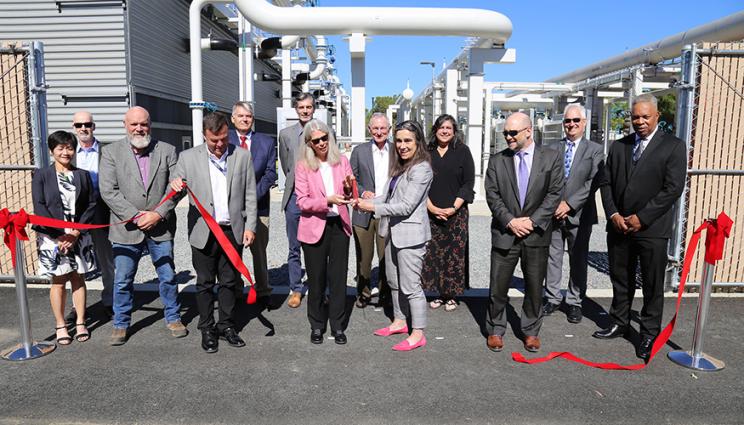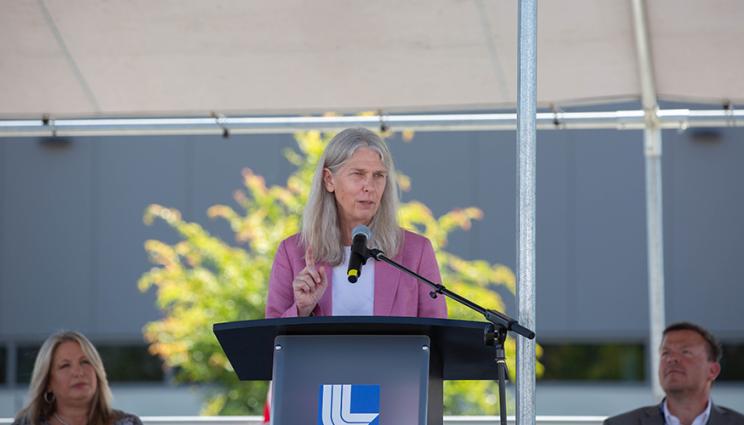
Department of Energy Under Secretary for Nuclear Science and Administrator for the National Nuclear Security Administration (NNSA) Jill Hruby (center, left) and Lawrence Livermore National Laboratory (LLNL) Lab Director Kim Budil on June 15 joined Exascale Computing Facility Project Manager Anna Maria Bailey and NNSA and LLNL Advanced Simulation & Computing leadership past and present to cut the ribbon marking the project's completion. The utility-grade infrastructure project massively upgraded the power and water-cooling capacity of the adjacent Livermore Computing Center, preparing it to house next generation exascale-class supercomputers for NNSA.
On June 15, Department of Energy Under Secretary for Nuclear Science and Administrator for the National Nuclear Security Administration (NNSA) Jill Hruby dedicated two critical infrastructure projects at Lawrence Livermore National Laboratory (LLNL), part of a three-day visit to the Lab.
Hruby attended ribbon-cutting ceremonies for the Exascale Computing Facility Modernization (ECFM) project and LLNL's new Emergency Operations Center (EOC), both of which provide essential upgrades to Lab capabilities. The projects finished ahead of schedule and under budget, despite the COVID-19 pandemic.
The $100 million ECFM - the Lab's first line-item project in more than a decade - is a significant boost to the power and water-cooling capacity of the Lab's Computing Center, preparing it to house exascale-class supercomputers that can perform more than one quintillion calculations per second.
With past and present leaders from NNSA's and LLNL's Advanced Simulation and Computing (ASC) programs looking on, Hruby congratulated design, planning and construction teams on completing the project, which will allow NNSA to field multiple exascale-class supercomputers simultaneously, including its first exascale system El Capitan, due to arrive at LLNL in 2023. The next-generation machines will allow NNSA and the ASC program to meet the certification requirements of the Stockpile Stewardship Program and aid in future design efforts, Hruby said.
"This kind of planning and execution in the modernization of our computing facilities enables us to move into the exascale era, and not only site El Capitan, but bring a second exascale-class system online in this next decade without having to turn off El Capitan first," Hruby said. "Given the dependence of the NNSA mission on high performance computing (HPC), ECFM is a visible sign to the rest of the world of NNSA's capability and intent to retain global leadership in HPC, which in turn contributes to our nation's deterrent."
Hruby and other speakers acknowledged ECFM Project Manager Anna Maria Bailey and the teams involved in the endeavor from NNSA, the Livermore Field Office (LFO) and engineering and construction crews, crediting them for their ability to deliver on the project nine months ahead of schedule and $9 million under budget, pandemic-related delays notwithstanding.
More than 15 years in planning and development, the ECFM project required an extensive permitting process, coordination with local utility companies and the contributions of hundreds of people. In an area adjacent to Building 453 - the Lab's main computing facility - construction crews installed a 115kV transmission line, air switches, substation transformers, a switchgear, relay control enclosures, 13.8 kilovolt secondary feeders and cooling towers.
Declared complete by NNSA on June 8, the ECFM infrastructure can supply the facility with 85 megawatts of electricity, up from the previous 45-megawatt capacity and enough to power a medium-sized city. It also expands the facility's water-cooling system from 10,000 tons to 28,000 tons.
Lab Director Kim Budil called the ribbon-cutting a "fitting moment" for the Lab, marking the next step in its legacy of leadership in supercomputing and ushering in an era that will foster external collaboration, bring talent to the Lab and generate new scientific discoveries across numerous disciplines, including climate science, design of therapeutics and vaccines, artificial intelligence and advanced manufacturing.
"The capability that we'll house here, El Capitan, will be the first exascale machine dedicated to national security. It will ensure our continued global leadership in HPC and open new vistas for scientific computing to support nuclear security, but it will do much more," Budil said. "We don't know today all that we will accomplish with this machine, which is another hallmark of the impact computing has had. It's always opened new avenues that we didn't anticipate."
LLNL ASC Program Director Rob Neely, who emceed the event, recognized teams from NNSA, LLNL, LFO, the Western Area Power Administration, engineering/construction firms Burns & McDonnell and Nova Probst and others for their work and perseverance in overcoming the challenges of COVID-19, wildfires and supply chain disruptions.
"This is really a major accomplishment for our national goal of sustaining an ongoing exascale computing capability for our national security mission," Neely said. "This effort really enhances Livermore's main computing building with a level of power and cooling that will serve us well into the future."
LFO Manager Pete Rodrik and LLNL Weapons and Complex Integration Principal Associate Director Brad Wallin also spoke at the event. Wallin commented on the significance of supercomputing and ECFM to the weapons program, saying that the upgrade will allow the Lab to pursue "new computing paradigms unconstrained by our infrastructure."
"ECFM is the bedrock to the computing foundation on which the future stockpile will be designed and assessed, and that will help the transformation of the nuclear security enterprise," Wallin said.
After the program concluded, Hruby, Budil and Rodrik, alongside NNSA and LLNL ASC leadership and representatives from the design, engineering and construction teams, performed the ceremonial ribbon-cutting.
Welcoming the state-of-the art in emergency response
Immediately following the ECFM dedication, Hruby joined Budil, Rodrik, state and city officials and local emergency responders on the Lab's far west side for a ribbon-cutting celebrating completion of the new EOC.
The $30 million, state-of-the-art facility brings LLNL's emergency response operations, management and alarms monitoring of Lab critical systems under one roof, comprising approximately 20,550 square feet of office space for Emergency Management Department staff and a central control room for Emergency Response Organization personnel. It is designed for self-sufficient operation for a minimum of 72 hours without support from Lab site infrastructure or services.
Construction on the EOC began in Oct. 2020 and finished in Dec. 2021, under budget and months ahead of schedule. The Department of Energy-funded project was part of an NNSA pilot program - Enhanced Minor Construction and Commercial Practices (EMC2) - aimed at streamlining delivery of commercial type, non-nuclear projects with price tags under $50 million.
LLNL's EOC is one of three similar emergency operations centers commissioned at NNSA sites under the pilot model - the others being the Y-12 National Security Complex and Sandia National Laboratories - and the first to be completed.
"NNSA quite literally broke new ground at Lawrence Livermore and across the complex with the success of this pilot," Hruby said. "The ever-present possibility of earthquakes, the 2019 fires and the subsequent air quality issues in Northern California, and the pandemic we are still living through, are examples of why the EOC is essential for the safety and security of Livermore's workplace and the communities we live in. I'm really excited about the success of this project, and I look forward to continuing to work with the Livermore team to innovate and modernize our infrastructure."
Hruby's remarks followed her tour of the facility with Budil, Rodrik, EOC Project Manager Joni Weamer and Operations & Business Principal Associate Director Cynthia Rivera. Also touring were distinguished guests and speakers Livermore Vice Mayor Regina Bonanno, Livermore City Manager Marianna Marysheva and Deputy Regional Administrator of the Coastal Region for the California Governor's Office of Emergency Services (Cal OES) Memoree McIntire.
Budil, the ceremony's emcee, said the EOC will fill critical gaps in the Lab's ability to respond to emergencies by consolidating operations in a "seismically sound, habitable and survivable" facility. She congratulated Weamer, design builder Burns & McDonnell, inspection teams and others involved in the project for exceeding expectations under the "extraordinary circumstances" presented by COVID-19, adding that its fast delivery under the EMC2 model sets a precedent for further "construction at the speed of light."
"Thanks to the success of this pilot, we have a new facility that meets our emergency response needs and NNSA requirements, supports mission delivery and makes us better partners to our community," Budil said. "And we have an example for how to do these kinds of projects in a really efficient and cost-effective way. This team deserves a lot of credit for being pioneers in this new pilot approach and really knocking it out of the park so that there will be more facilities to come under the model."
Located outside the Lab's main gates off Mesquite Way, the EOC is easily accessible for local fire and emergency crews, first responders and public officials. Invited speakers said the facility would help ensure a coordinated, multi-agency response to emergencies and natural disasters, and strengthen the collaboration between the Lab and the community.
Livermore's Bonanno said in the event of a local emergency, the facility will work together with the city's new, recently dedicated EOC at the Livermore Civic Center, enabling an effective and efficient response, not just at the Lab, but city-wide.
"The key to a successful response is cooperation and coordination and over the past five years, the Lab and city have been working to develop an integrated emergency capability," Bonanno said. "Together, these new facilities strengthen our commitment to ensuring the safety of the public and the environment on both sides, as well as across the fence."
With Livermore Police Chief Jeramy Young, local law enforcement and crews with the Livermore-Pleasanton Fire Department and Alameda County Fire Department in attendance, Cal OES's McIntire reiterated the importance of mutual aid among state, federal and local responders, adding that the EOC will benefit the entire region.
"This new facility is designed with the intent to facilitate multi-agency coordination and the collaboration between emergency responders at the Laboratory and local community, which is an asset to us all," McIntire said. "It's clear the project team succeeded in its goals of designing and building an emergency operations center that ensures the Lab is prepared to provide a well-coordinated and fully supportive, integrated response to significant emergency or incident."
Following McIntire, Gary Prost, senior district representative for U.S. Congressman Jerry McNerney (D-Stockton), presented Budil with a certificate of Congressional recognition for the Lab honoring the project's completion, noting that the EOC exemplifies the longstanding relationship between the Lab and the community.
"This new facility is critically important," Prost said. "It's here to protect and respond to emergencies, protect the work being done here at the Lab and the people doing it, but also to protect the community around the Lab."
After the ribbon-cutting ceremony, the facility opened its doors to attendees for a reception and self-guided tours.
For more on the ECFM and EOC projects, visit:
- https://www.llnl.gov/news/powering-llnl-prepares-exascale-massive-energy-and-water-upgrade
- https://www.llnl.gov/news/lab-breaks-ground-exascale-facility-upgrades
- https://www.energy.gov/nnsa/articles/nnsa-capitalizes-innovation-modernize-infrastructure-bolster-safety-and-increase
- https://www.energy.gov/nnsa/articles/nnsa-administrator-dedicates-breaks-ground-new-llnl-facilities-support-nation-s







